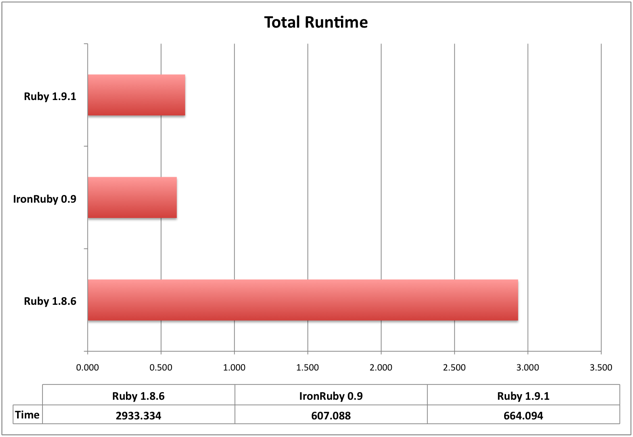IronRuby Progres
Antonio Cangiano from IBM compares the performance of the recently released IronRuby with Ruby 1.8 and 1.9 on Windows.
On his blog post he looks at both the micro benchmarks and overall benchmarks. The summarized results:

Antonio comment:
IronRuby went from being much slower than Ruby MRI to considerably faster across nearly all the tests. That’s major progress for sure, and the team behind the project deserves mad props for it.One final warning before we get too excited here. IronRuby is not faster than Ruby 1.9.1 at this stage. Don’t let that first chart mislead you. While it’s faster in certain tests, it’s also slower is many others. Currently, it’s situated between Ruby 1.8.6 and Ruby 1.9.1, but much closer to the latter. The reason why this chart is misleading is that it doesn’t take into account any tests that timed out, and several of such timeouts were caused by IronRuby (more than those caused by Ruby 1.9.1). If you were to add, say, 300 seconds to the total, for each timeout for the two implementations, you’d quickly see that Ruby 1.9.1 still has the edge. The second chart that compares macro-benchmarks does a better job at realistically showing how IronRuby sits between Ruby 1.8.6 and Ruby 1.9.1 from a performance standpoint. If you were to plot every single benchmark on a chart, you’d find a similar outcomes for a large percentage of the tests.
Whether it’s faster than Ruby 1.9 or not, now that good performances are staring to show up, it’s easier to see IronRuby delivering on it’s goal of becoming the main implementation choice for those who both develop and deploy on Windows. This, paired with the .NET and possible Visual Studio integration, the great tools available to .NET developers, and the ability to execute Ruby code in the browser client-side thanks to projects like Silverlight/Moonlight and Gestalt, make the project all the more interesting.
Posted on 03 Aug 2009
Blog Search
Archive
- 2024
Apr Jun - 2020
Mar Aug Sep - 2018
Jan Feb Apr May Dec - 2016
Jan Feb Jul Sep - 2014
Jan Apr May Jul Aug Sep Oct Nov Dec - 2012
Feb Mar Apr Aug Sep Oct Nov - 2010
Jan Feb Mar Apr May Jun Jul Aug Sep Oct Nov Dec - 2008
Jan Feb Mar Apr May Jun Jul Aug Sep Oct Nov Dec - 2006
Jan Feb Mar Apr May Jun Jul Aug Sep Oct Nov Dec - 2004
Jan Feb Mar Apr May Jun Jul Aug Sep Oct Nov Dec - 2002
Jan Feb Mar Apr May Jun Jul Aug Sep Oct Dec
- 2022
Apr - 2019
Mar Apr - 2017
Jan Nov Dec - 2015
Jan Jul Aug Sep Oct Dec - 2013
Feb Mar Apr Jun Aug Oct - 2011
Jan Feb Mar Apr May Jun Jul Aug Sep Oct Nov Dec - 2009
Jan Feb Mar Apr May Jun Jul Aug Sep Oct Nov Dec - 2007
Jan Feb Mar Apr May Jun Jul Aug Sep Oct Nov Dec - 2005
Jan Feb Mar Apr May Jun Jul Aug Sep Oct Nov Dec - 2003
Jan Feb Mar Apr Jun Jul Aug Sep Oct Nov Dec - 2001
Apr May Jun Jul Aug Sep Oct Nov Dec